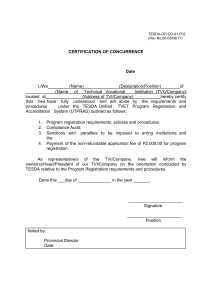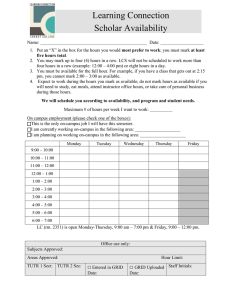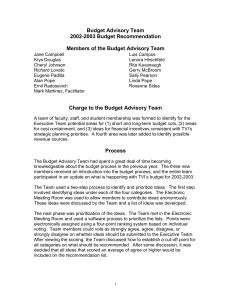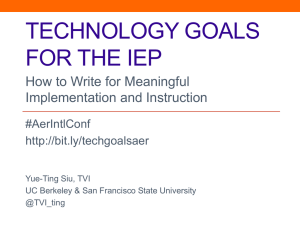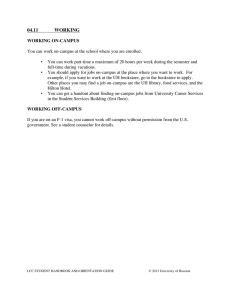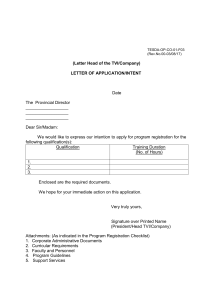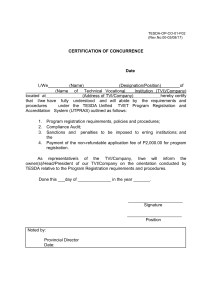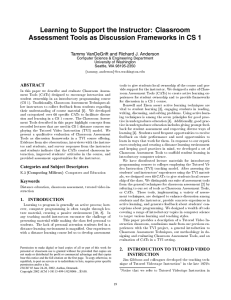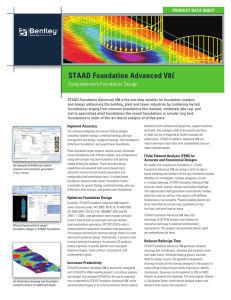Pilot Year Distance Learning Study
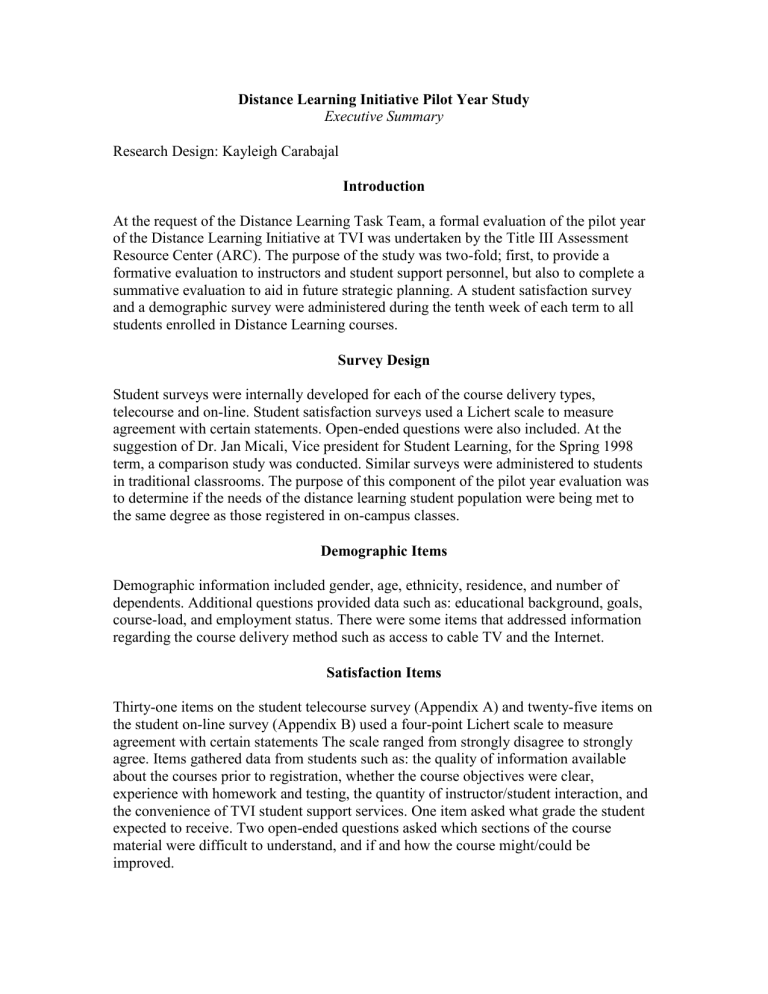
Distance Learning Initiative Pilot Year Study
Executive Summary
Research Design: Kayleigh Carabajal
Introduction
At the request of the Distance Learning Task Team, a formal evaluation of the pilot year of the Distance Learning Initiative at TVI was undertaken by the Title III Assessment
Resource Center (ARC). The purpose of the study was two-fold; first, to provide a formative evaluation to instructors and student support personnel, but also to complete a summative evaluation to aid in future strategic planning. A student satisfaction survey and a demographic survey were administered during the tenth week of each term to all students enrolled in Distance Learning courses.
Survey Design
Student surveys were internally developed for each of the course delivery types, telecourse and on-line. Student satisfaction surveys used a Lichert scale to measure agreement with certain statements. Open-ended questions were also included. At the suggestion of Dr. Jan Micali, Vice president for Student Learning, for the Spring 1998 term, a comparison study was conducted. Similar surveys were administered to students in traditional classrooms. The purpose of this component of the pilot year evaluation was to determine if the needs of the distance learning student population were being met to the same degree as those registered in on-campus classes.
Demographic Items
Demographic information included gender, age, ethnicity, residence, and number of dependents. Additional questions provided data such as: educational background, goals, course-load, and employment status. There were some items that addressed information regarding the course delivery method such as access to cable TV and the Internet.
Satisfaction Items
Thirty-one items on the student telecourse survey (Appendix A) and twenty-five items on the student on-line survey (Appendix B) used a four-point Lichert scale to measure agreement with certain statements The scale ranged from strongly disagree to strongly agree. Items gathered data from students such as: the quality of information available about the courses prior to registration, whether the course objectives were clear, experience with homework and testing, the quantity of instructor/student interaction, and the convenience of TVI student support services. One item asked what grade the student expected to receive. Two open-ended questions asked which sections of the course material were difficult to understand, and if and how the course might/could be improved.
Conclusions
The following conclusions can be made from information collected from the Pilot Year
Distance Learning evaluation:
The Distance Learning Initiative is reaching an expanded population. Fifty percent of the students would not have enrolled in another on-campus course had it not been offered in a Distance Learning format.
Students are successful in Distance Learning courses. Course retention rates are
very similar to traditional on-campus courses.
The student population differs from the overall TVI student population. The
majority of students enrolled in Distance Learning courses were female, age 31 or above, married, had dependents, and lived within the Albuquerque metropolitan area.
Student support for this population of learners is a critical issue. Over half are first
generation college students who have had some college experience but had not ever before enrolled in Distance Learning courses.
Course information is important to this population of students. The TVI Class
Schedule Book remains the primary initial source of information regarding
Distance Learning courses.
The most important reason cited for taking this type of course was the conflict of on-campus courses with their work schedules. One-quarter of the students enrolled due to an inability to enroll in an on-campus course.
Courses offered via Distance Learning modalities are more challenging in terms of study time demanded according to the students self-report.
Overall, students were satisfied with their experiences taking Distance Education courses.
The course registration process was convenient for students.
Distance Learning courses were valuable and contributed to students' learning.
Students agreed that they would take another Distance Learning course and
recommend them to other students.
Students thought that homework and tests fairly tested their understanding of course content.
The opportunities for leaving messages for the instructor and interaction with the instructor was satisfactory. Feedback from instructors was prompt.
Students were satisfied overall with student support services.
Summary:
The research literature on Distance Learning suggests a positive correlation between student satisfaction and student success. In light of the overall favorable response to
Distance Learning courses, students recommended they be expanded at TVI. Overall, students were satisfied with their experience in Distance Education courses, would enroll in additional courses of this type, and recommend them to other students. These courses fill the need of students who work full time and may have family responsibilities or scheduling conflicts. Similar retention and C-Pass rates were recorded for the thirty-eight
Distance Learning sections offered during the pilot year and overall TVI rates.
Areas of opportunity for improvement exist in increased faculty training, expanded orientation sessions and information in the TVI schedule of classes. It is recommended that an evaluation such as this be continued on an annual basis. Invaluable information, both formative and summative, has been made available as a result of this study. Further studies are recommended to determine the optimal type of information students require concerning these courses as well as the training needs for faculty.
